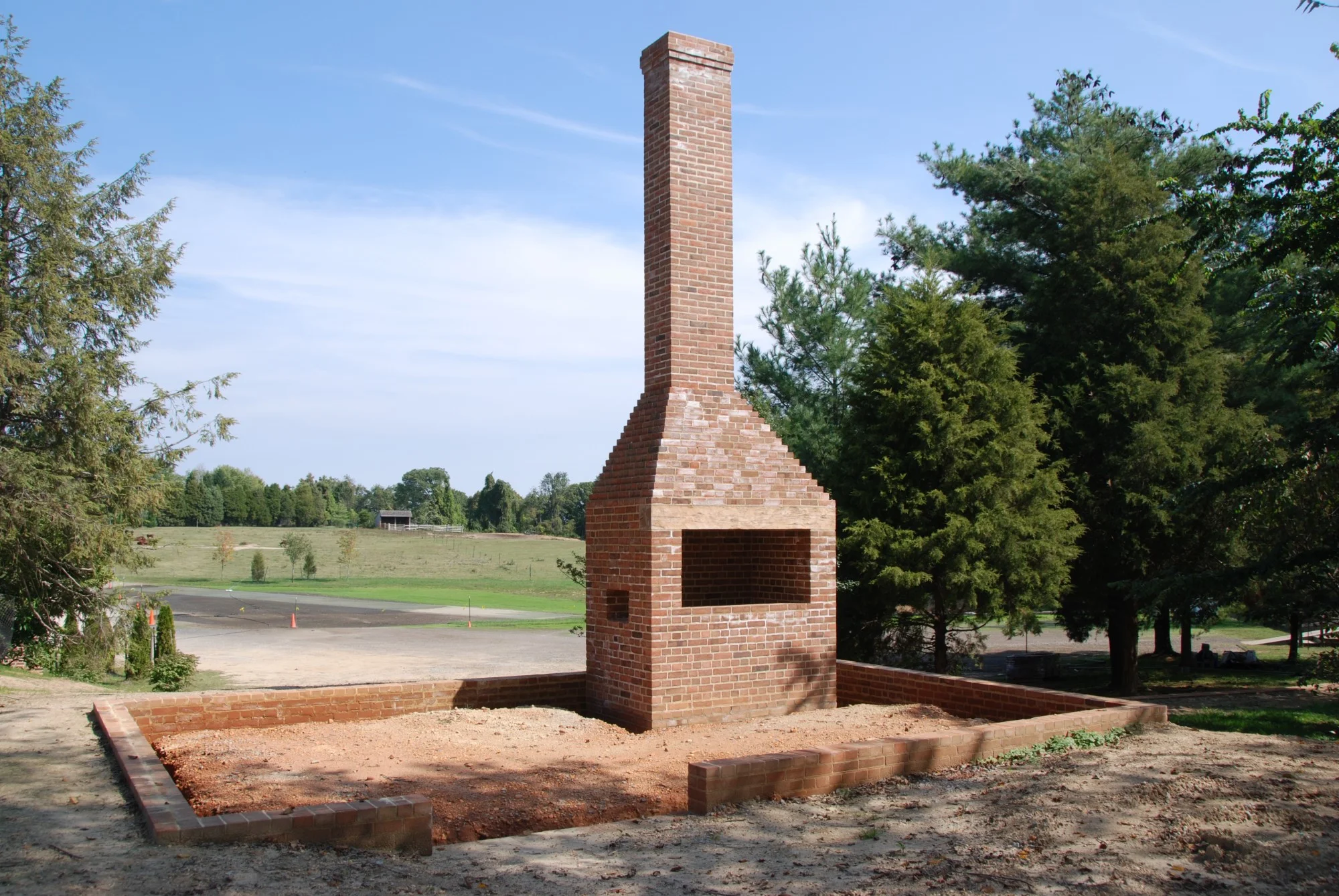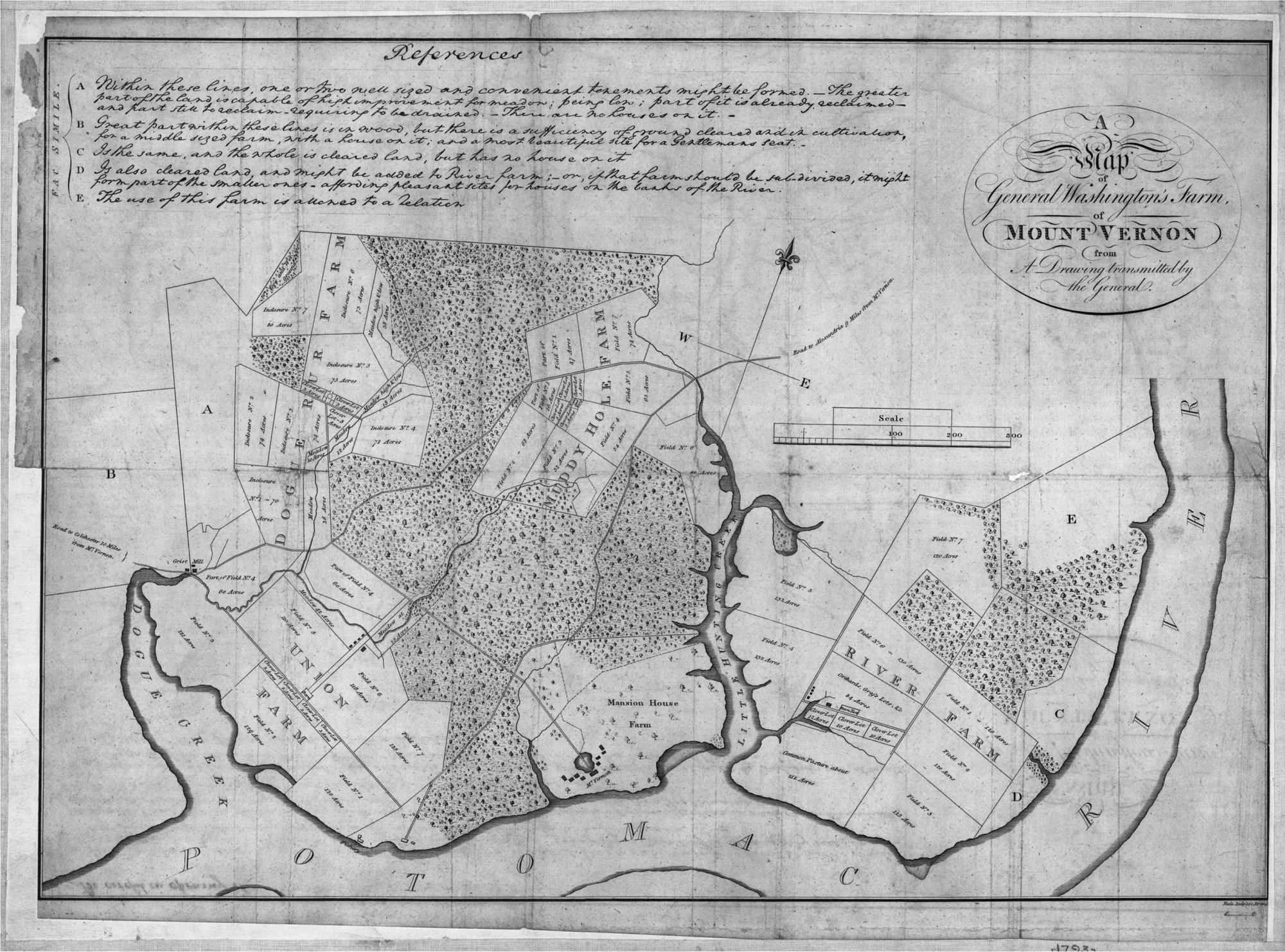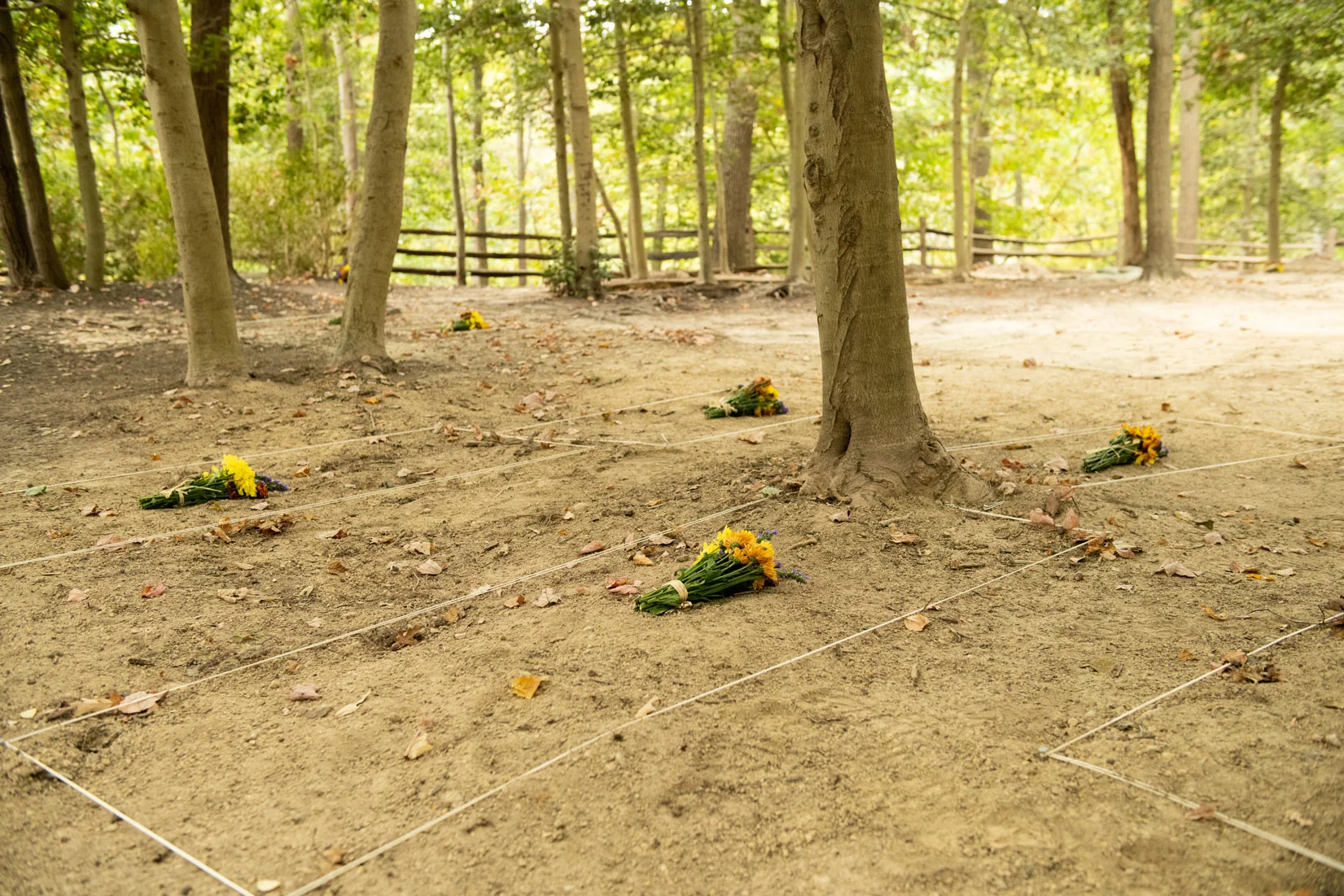Early Investigations
In the mid 20th century, archaeological investigations at Mount Vernon were conducted by contractor archaeologists and historians, including Morley J. Williams (1931–1939), Walter M. Macomber (1941–1974), and a contracted survey of the estate was conducted by the Virginia Division of Historic Landmarks (1984–1985).
Establishing a Permanent Archaeology Department
Based on the Virginia Division of Historic Landmarks survey, the Mount Vernon Ladies' Association concluded that a permanent archaeology department was needed. This department became an integral component of the Association’s ongoing research program.
North Grove Blacksmith Shop Site
In 1987–88, the excavation of the blacksmith shop in the north grove was completed. Substantial structural evidence for the shop itself was revealed, allowing for the creation of a relatively detailed interpretation of the layout of the shop and surrounding yards. The findings include the assessment that the shop was in existence until at least circa 1799. The decision was made by the Restoration Committee of the MVLA in 1989 that insufficient evidence to warrant the reconstruction of the blacksmith shop. Several years later, this decision was revisited, and the blacksmith shop was completed in 2009.
Laundry Yard
Over the course of two years, a site postulated as a possible second smith’s shop was intensively excavated. A substantial brick and stone foundation, first discovered in 1936 and completely revealed and photographed in 1946, was the focus of this investigation.
Several characteristics of the foundation suggested that it may have been the base of a blacksmith’s forge. No artifacts supporting that hypothesis were recovered. Several years later research revealed that the structure related to Bushrod Washington’s occupation known as a “cow-food boiler.”
Evidence for a fenceline that matches a line on the south end of the yard marked on the Vaughan plan of 1787 also was found. However, in 2012 fieldwork determined that the existing fenceline dated after 1799, resulting in its removal.
Vineyard Inclosure
Archaeological investigations were part of the research leading to a proposed recreation of the area referred to by George Washington as the “Vineyard Inclosure.” The area served a number of functions, including as an experimental vineyard in the 1770s, then as a formal fruit garden and a nursery for a variety of types of plants beginning circa 1786. As such, it was an important component of the plantation and supported George Washington’s many horticultural experiments.
Archaeological evidence found includes boundary fences, ditches that probably served for drainage as well as for boundaries and partition, and possible tree planting holes that appear associated with the fruit garden. The data points to an enclosed area, approximately 420-feet square in size, that seems likely to separate the "Vineyard Inclosure", and contain a smaller area, approximately 260-feet square, that is hypothesized as a fruit garden.
A plan for recreating the area was developed and the recreation exists today.
South Grove
Beginning in the summer of 1990, a multi-year investigation of the area situated just south of the Mansion and Kitchen was initiated. The site was selected as the result of numerous 18th-century artifacts being found there over the years, combined with its high potential for yielding domestic artifacts associated with the daily life of the Washington household and the enslaved community.
An extensive midden, or trash pit, was partially revealed and tested in 1990, with two much larger portions exposed in 1991 and 1992. The midden was at least 30 feet in diameter and in excess of 1.5 feet in depth at its center. Excavations yielded enormous quantities of faunal remains, ceramics, wine bottle glass—including three different bottle seals—table glass, tobacco pipes, and a wide range of personal and household objects. Based on the materials recovered to date, the midden appears to have been deposited just prior to the American Revolution.
In addition to the midden, several subterranean brick drains also were revealed. Two of the drains apparently connect with the Mansion basement and with the Kitchen larder, and date to a period of construction and major renovation carried out in the 1770s. A third drain may be associated with the earlier kitchen, built before 1752 and demolished in 1775.
Union Farm Survey
An archaeological survey of a portion of George Washington’s Union Farm was conducted in 1991 and 1992 in attempt to identify quartering sites on seven relatively undisturbed acres near a 19th-century farmhouse. No cultural features were identified during the course of the survey. 18th and 19th-century artifacts were recovered in plowzone contexts, potentially indicating the former presence of field quarters within the survey area.
Dung Repository
Archaeological investigations at the site of the Dung Repository, south of the South Grove begun in 1993 and continued until 1995. The investigation fully uncovered the existing wall foundations on the east and west sides and a cobblestone floor. Seven post holes were uncovered on the south wall and are associated with a later 19th-century building.
Based on the excavations and documentary research the Dung Repository was reconstructed in 2001.
Dogue Run Survey
A survey of three properties associated with a barn found on the Dogue Run farm was conducted between April 1992 and August 1993. The survey revealed a brick clamp likely from the construction of the 16-sided treading barn and a ditch marking the boundary between the agricultural fields.
Carpenter's Shop and Pisé Barn
Between 1995–1998, an archaeological campaign seeking to locate the carpenter’s shop indicated on the historic Vaughan Plan was undertaken. Destroyed by fire in 1793, the shop has remained elusive since it vanished from the Mount Vernon landscape.
Prior attempts by Morley Williams to locate the structure in the 1930s were unsuccessful. Though no traces of the carpenter’s shop were found, foundations to a pisé barn and dairy from Bushrod Washington’s occupation of the estate (1802-1829) were discovered during the course of the 1990s excavation.
Additionally, limited testing of the paddock was conducted in 2013, 2014, and 2015.
HVAC Installation
A Heating, Ventilation, and Air Conditioning (HVAC) system servicing the Mansion was installed in 1998 that included an underground access bunker as part of the operating system. A 40’ × 45’ area north of the servant’s hall was tested as part of this infrastructure campaign; no archaeological features were discovered.
Mansion Drain
Between 1994–1997, an archaeological excavation was conducted before the installation of a perimeter drain around the Mansion. New information about the use of the Mount Vernon estate from 4,000 years ago until the present and new evidence relating to the structural evolution of the Mansion were discovered.
Components of an 18th-century brick drainage system were discovered along the north and south sides of the Mansion. A portion of cobblestone paving and two sections of brick paving were uncovered along the west façade. These surfaces, combined with remnants of 18th-century topsoils, provide excellent documentation for the changing landscape surrounding the Mansion.
A series of cultural features hint at an earlier configuration of both the Mansion and the adjacent landscape. Four trenches were interpreted as foundations of walls which radiated from the corners of the pre-1775 Mansion configuration. Postholes were discovered below each foundation trench, thought to be evidence for an earlier fence line connecting the Mansion to flanking outbuildings. The location and stratigraphic position of two postholes discovered along the east façade suggests they were part of an entrance feature that existed prior to the construction of the piazza.
Upper Garden
In November and December of 1997, archaeological testing was conducted in the east and west parterres of the Upper Garden, prior to grading, soil enrichment, and replanting of boxwoods by Mount Vernon horticultural staff. The foundation of a structure dating to 1801 was uncovered in the west parterre. Intact bricks were found along the west wall. A strip of mortar remained along the south wall and in the southeast corner indicating that at least part of the foundation had been robbed. The north and east walls lay protected under the garden walks and were not disturbed. The remains of another structure were discovered to the west of this building.
Washington's Mill Historical State Park
In 1997, archaeologists conducted a Phase I and limited Phase II survey of Washington’s Mill Historical State Park prior to its acquisition by the MVLA. The survey was designed to assess the potential for significant archaeological features and to identify areas of intact cultural remains. The survey found features associated with George Washington’s 18th-century gristmill, distillery, and miller’s cottage.
Servant's Hall
In 1998, archaeologists excavated beneath the floor of the servant’s hall as part of the restoration of that building. During the excavation, a portion of the foundation of the pre-1775 wash house was uncovered. It is hypothesized that the portion uncovered may have been the base of the fireplace for the wash house. A small trash filled depression was situated just outside of the earlier wash house. A rich assemblage of architectural, domestic, and faunal artifacts were recovered. Virtually all of the artifacts recovered date to the wash house occupation circa 1740–1776.
Distillery Excavations and Reconstruction
The distillery excavations began in the summer of 1999 and continued through the summers of 2002. During the first two seasons, layers that postdated the distillery period were removed stratigraphically. The east and south stone walls were exposed along with numerous cultural features associated with the structure’s usage as a commercial distillery. Documentary sources indicate that six enslaved laborers and one distiller worked and lived in or near the distillery.
During the summer of 2000 the Distilled Spirits Council of the United States (DISCUS) became aware of the archaeological project and contributed 1.2 million dollars to assist with funding the archaeology and the reconstruction of the distillery. The reconstruction was completed in 2006.
Restrooms and Security Installation
The installation of a restroom and new security building on the North Lane was undertaken between 2001–2004. Archaeological testing occurred intermittently as work took place. This was due to the few records that survive pertaining to the layout and use of the space during George Washington’s era.
The area seems to primarily have been the site of an unknown number of cabins for enslaved workers, probably arranged in a line adjacent to the lane, along with various garden plots maintained by the inhabitants. Any archaeological remains relating to these structures were probably completely destroyed when an administrative building was constructed in the 1980s. The remains of a brick lined well survive that served as the source of water for those who lived in the cabins, and the enslaved laborers living in the brick Greenhouse quarters nearby. Other landscape features that are known to have been carried out in the general vicinity are a clover lot, an orchard, and a mule paddock.
Unfortunately no detailed information exists to indicate the exact location or the appearance of any of these features. Archaeological excavations conducted in advance of constructing the restroom-security building revealed no evidence of buildings or other activities. Several post holes/molds were found that form a line and relate to a fence that ran along the lane and connected to the corner of the Blacksmith Shop.
Reconstructing the Upper Garden
Archaeologists returned to the upper garden in 2005. Based upon the initial surveys of the garden, it was believed that much of the 18th-century garden complex had not survived and that the preservation potential was rather low. However, garden paths and planting beds were identified during the investigations, indicating that much of the garden had indeed not only survived but had remained intact throughout the years.
The following three years of fieldwork were intensive excavations designed to identify the history of the garden and to provide the basis for an accurate restoration of the 1799 garden. A variety of primary and secondary sources were consulted to complement the archaeological discoveries.
In 2009 a charrette was convened at Mount Vernon to evaluate the archaeological and documentary evidence and to guide the remaining research. The consensus was the garden space looked similar to how it was depicted on the Vaughan Plan. Vegetables were sited at the center of the larger beds, enclosed by a ten-foot border of flowering plants accompanied by fruit trees and complemented by a perimeter of boxwood. The restoration was completed in 2011.
Washington Library
From 2008–2010, Mount Vernon’s archaeologists conducted an archaeological survey and assessment at the site of the Fred W. Smith National Library for the Study of George Washington. The archaeological work focused on an approximately four-acre wooded knoll comprising a Late Archaic Period prehistoric component and a historic component dating to the late 18th–early 19th centuries.
A total of 1,119 shovel test pits and 421 5’ × 5’ test units were excavated and more than 25,000 artifacts recovered. No cultural features were identified.
The findings suggest an early 19th-century occupation with several of the ceramic artifacts dating to the first two decades. The numbers of ceramics, glass, and architectural remains suggest domestic occupations, perhaps three houses or a combination of dwellings and outbuildings, but the absence of cultural features makes this interpretation speculative.
Kitchen
In 2013, excavations on the north and west sides of the 1775 Kitchen foundation were undertaken as part of a campaign to mitigate defunct utilities from the 1950s. Fieldwork uncovered part of the sandstone-block foundation to the pre-1775 dairy as well as a hearth to the pre-1775 kitchen. Along the west side of the extant kitchen several scaffolding holes were uncovered along with part of the south foundation wall.
The following season archaeologists focused efforts on the Kitchen’s south side, uncovering masonry rubble from the destruction of the pre-1775 kitchen. Two brick drains from the extant kitchen were also uncovered.
North "Wilderness"
In 2014, Mount Vernon archaeologists commenced a multi-phase survey of a section on the estate known by George Washington as a “wilderness”. There were two wildernesses located on the north and south ends of the west side of the bowling green, laid out in the mid-to-late 1780s. In collaboration with Mount Vernon’s horticulture division and the Garden Club of Virginia, archaeologists tested and assessed the north wilderness area and identified features related to this landscape component.
African American Burial Ground Survey
Beginning in the summer of 2014, Mount Vernon archaeologists embarked on a multi-year archaeological survey of the African American Burial Ground located on the estate. The primary goal of this project is to create a map that shows exactly where individuals are interred on the ridge just southwest of Washington’s tomb.
Archaeologists have uncovered more than 80 burials. Each was thoroughly documented at its highest possible elevation, and no human remains were encountered or disturbed. Archaeologists will continue excavations in the African American Burial Ground in the coming years.
Mansion Cellar
Mount Vernon's archaeological team undertook excavations in the Mansion basement in 2018. Beneath the brick paving in the cellar, our archaeologists found evidence of the evolution of the house during its ownership by the Washingtons. These excavations revealed a series of drains and wall foundations each built at different periods of the basement expansion. By carefully uncovering the relationships between each of these drains and foundations, our team contributed to a more detailed and accurate understanding of when and how the cellar was created and reshaped by George Washington during his lifetime.
"Old Necessary"
Mount Vernon archaeologists have relocated a Washington-era building while conducting an archaeological survey on the east lawn. George Washington wrote from the presidential residence in Philadelphia to his farm manager at Mount Vernon, “I have several times spoke concerning a necessary for the Quarter People, at Mansion house . . . I wish you would have this done before We come home that the yard of the Quarter may be always clean & Sweet. If the old necessary on the brow of the Hill can be moved with more ease than building a new one, let it be done, as it is not only useless where it is but is an eye-sore.”
Ask an Archaeologist
Curious when and where you can see Mount Vernon's archaeology team at work? Want to understand what they are looking for?
Find Out












